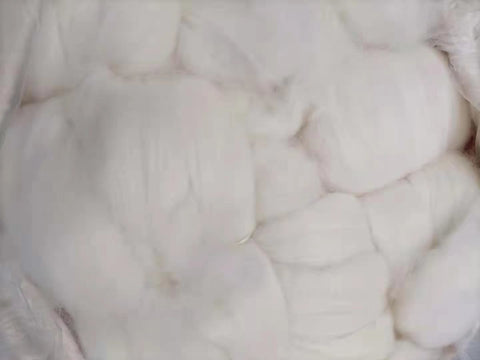SAVE UP TO 30% OFF
SAVE UP TO 30% OFF
Add description, images, menus and links to your mega menu
A column with no settings can be used as a spacer
Link to your collections, sales and even external links
Add up to five columns
Add description, images, menus and links to your mega menu
A column with no settings can be used as a spacer
Link to your collections, sales and even external links
Add up to five columns
Cashmere Grades and Quality Explained
November 05, 2021 4 min read
When we talk about 100% cashmere, we may misunderstand the term 100%, in fact, there are three different cashmere grades which decide the cashmere quality. These grades can be broken down into three: A, B and C.

Cashmere is a very unique and special material. It is probably one of the most precious natural fabrics in the world. But when we try to buy cashmere scarves or sweaters, do you know which cashmere grade they are made of? Do you know your shawls, hats or gloves are made of hight quality cashmere? Different cashmere grades decide different cashmere products quality.
What is cashmere grades?
Experts determine the cashmere grades based on the fineness and the length of hairs found on the fiber. Generally speaking, the higher grade, the higher quality cashmere. Below we will explain different grades of cashmere.
Different grades of cashmere
Grade A
Grade A cashmere is the most expensive cashmere in the market, because it is thinnest, longest and most durable. Grade A cashmere is 14 microns, and the length is around 36mm.
Grade B
Grade B cashmere is about 19 microns while it is thicker than Grade A.
Grade C
Grade C cashmere is low quality cashmere in the market, it is about 30 microns, more thicker than grade B. It is the cheapest cashmere in all of them.
| Cashmere Grade | Quality | Specification |
| A | Hight quality | 14 microns, 36mm in lenghth |
| B | Middle quality | 19 microns |
| C | Low quality | 30 microns |
What does Ply Mean and what ply is best?
Ply is the number of cashmere threads twisted together to make the cashmere yarn.
Two twisted threads are referred to as 2-ply, and three twisted threads are referred to as 3-ply etc. 1-ply is designed to be thinner and more elastic, so it is not as warm as thicker cashmere. 2-ply is the ideal type of cashmere because it maintains a balance of warmth, elasticity and light weight. 3 to 4-ply is not necessarily warmer nor softer, however it will be significantly heavier than 2-ply cashmere.
Look for items that are 2-ply or higher, as 1-ply cashmere is less durable and is more likely to develop holes. Higher plies such as 4-ply add additional weight and warmth, but do not indicate additional quality.
What does gauge mean and what is the best gauge?
Gauge refers to the number of stitches or rows per inch and is a measure of how tightly the item is knitted. The higher the gauge number the tighter the knit and the more cashmere yarn that is being used.
Cashmere garments are commonly knitted in 7 gauge (7GG) and 12 gauge (12GG).
7 gauge has 7 stitches or rows of yarn per inch of the knitted cashmere, so the cashmere has a more open or mesh like look and is lighter. 12 gauge has 12 stitches or rows of yarn per inch, so the cashmere is relatively dense.
A lower gauge number will provide a lighter item as less cashmere is being used. If you are looking for a lightweight item, then a lower gauge is best. If your priority is warmth or durability, then a higher gauge will be preferable.
Additional ways to determine the quality of cashmere
Finger touch check
The best way to determine the quality of this luxurious material is to use your fingers. Simply touch the cashmere product and feel it. Cashmere that comes with high quality and unique texture is made of long fibers, so you should feel incredible softness and pleasant sensation on the tips of your fingers.
In some cases, although you feel very soft when you touch the cashmere product, it does not mean the item has grade A cashmere.
Stretch capability check
Furthermore, you can also test the stretching capability of the material. Cashmere is very durable and should remain in the same shape for a long period of time.
Gently stretch out a piece of the cashmere and see if it springs back into shape. Good quality cashmere will, lower quality cashmere will remain out of shape. Also stretch it and look through it. The tighter the knit of the cashmere the better quality it is and the better it will retain its shape as well as being less susceptible to holes.
Color check
If the manufacturer did not treat the cashmere carefully in the process of cashmere production, or use very low quality dye, the fabrics will become rough. This situation usually happens on black and dark colored cashmere products.
If you are not familiar with cashmere, you can not recognize it in detail. So if someone wants to buy cashmere products, he or she should choose lighter colors products at the beginning.
Price check
Please remember that the price is also a significant factor about the quality. In case you got a cashmere product that is incredibly cheap, obviously, it is a fake or low quality product.
Smell check
Also, you can check if the cashmere quality is high by smelling. We have mentioned about the cashmere making process in another post, if you find some special smell in cashmere, there must be some problem in the process. The dealers do not follow every step to handle the cashmere material, they just want to to save time or money. So the cashmere quality is not assured.
Pilling check
Does Your Cashmere Item Pill? Yes, we have a post about why does cashmere pill?
Pilling usually forms on the arms, elbows, sleeves, or other clothing pieces. The shorter the fibers of a fabric, the more easily they get twisted up and knotted.
All you need to do is run your hand over the cashmere. You may notice right away that little wads of fibers are forming. That means there are shorter fibers within the fabric, which is indicative of a lower quality. All cashmere pills when met with friction over time, but only the lowest quality will pill rapidly.
|
About Ying Tang Miss Ying, cashmere products quality controller in Dr.Muxue, with 10 years of experience in cashmere material selecting and cashmere material purchasing, deeply knows the process of cashmere garment producing as well as how to take care of them. |
About Dr.Muxue
Dr.Muxue is one new brand in cashmere scarf industry, all products are 100% cashmere, made in Inner Mongolia. We are willing to offer excellent cashmere products for you.
Mens
Subscribe
Sign up to get the latest on sales, new releases and more …

